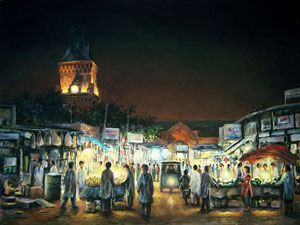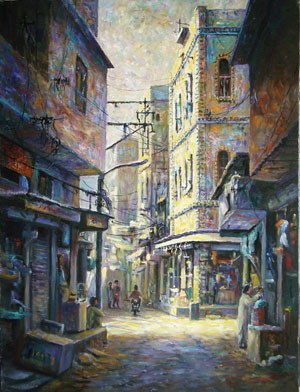Hanif Shehzad’s Ode to Karachi
By Nudrat Kamal | Art | Arts & Culture | Published 13 years ago
The first thing you feel when you look at Hanif Shehzad’s paintings of Karachi is that you have stepped back in time, to a Karachi of long ago. The Karachi he depicts is serene and tranquil, exuding a sort of peacefulness that has become foreign to this troubled city of late. And yet these paintings, showcased at the Chawkandi Art gallery in September, are all fairly recent. Is it nostalgia and a longing for the past that makes these paintings so different from the violent and turbulent city we see on the news today? Not, according to Shehzad. “I know it seems like this city only has darkness, but for me Karachi is still alive and full of hope.” Beauty, as they say, lies in the eye of the beholder.
Shehzad’s use of vibrant colours and bold brush strokes makes the city come alive in each of his paintings. Most of his work depicts the older parts of the city, with colonial and Hindu architecture, the type of architecture Shehzad is especially drawn to. The reason Shehzad started painting Karachi in the first place was his love for the city and its architecture. “The old city has such a rich heritage. You can find different types of buildings here — buildings belonging to Hindus, Muslims and the British.” In his painting ‘Kharadar Street,’ he masterfully captures a lazy afternoon in a meandering street surrounded by some of the oldest buildings in Karachi. With half the street bathed in sunlight and the other half shadowed by the looming buildings, Shehzad’s skill of playing with different kinds of light to create the transitory nature of the moods of the city is at its best here.
 Another aspect of Karachi featured prominently in Shehzad’s paintings is its bustling and lively marketplaces. There are several paintings of Empress Market during different times of the day, from the Empress Market under the scorching afternoon sun to one which is lit up by the lanterns of vendors lined up outside the market gates. The marketplace scenes lack the frenzy and chaos that is so characteristic of Empress Market but underline the theme of a tranquil Karachi that Shehzad is trying to portray.
Another aspect of Karachi featured prominently in Shehzad’s paintings is its bustling and lively marketplaces. There are several paintings of Empress Market during different times of the day, from the Empress Market under the scorching afternoon sun to one which is lit up by the lanterns of vendors lined up outside the market gates. The marketplace scenes lack the frenzy and chaos that is so characteristic of Empress Market but underline the theme of a tranquil Karachi that Shehzad is trying to portray.
Shehzad is especially adept at capturing Karachi at nightfall, illuminated by the moonlight or street lamps which cast interesting shadows over its streets and buildings. He actually prefers painting Karachi at night. “You see a whole different side of Karachi at night, and I wanted to show all the different facets of my city. I also enjoy the fact that I can experiment more with light in these paintings.” The trick, he explains, is to select which light sources to use. “A Karachi street at night is lit up with so many different sources of light — street lamps and coloured lights from shops and vendors. In my paintings, I choose only a handful of light sources which create the most fascinating effect.” In his painting ‘Commercial Market, PECHS,’ the street is lit with a green bulb hanging from a tree, giving an almost eerie feel to the surrounding area.
 One of the most breath-taking paintings of the show is ‘Mohatta Palace in the moonlight,’ in which Shehzad reveals the architectural glory of the palace bathed only in moonlight. With thick foliage in the foreground and the majestic palace in the background, the painting is hauntingly beautiful. The moonlight accentuates its grandeur while giving it an almost ethereal quality.
One of the most breath-taking paintings of the show is ‘Mohatta Palace in the moonlight,’ in which Shehzad reveals the architectural glory of the palace bathed only in moonlight. With thick foliage in the foreground and the majestic palace in the background, the painting is hauntingly beautiful. The moonlight accentuates its grandeur while giving it an almost ethereal quality.
Each of Shehzad’s paintings is an ode to the city he loves and admires. The message he wants viewers to take away from his paintings is simple. “I don’t have a profound message to give. All I want is for people to see Karachi as I do — a city which is still vibrant and lively; a city which, despite all it goes through, still manages to remain hopeful.”
This article was originally published in the October issue under the headline “Ode to Karachi.”
Nudrat Kamal teaches comparative literature at university level, and writes on literature, film and culture.


